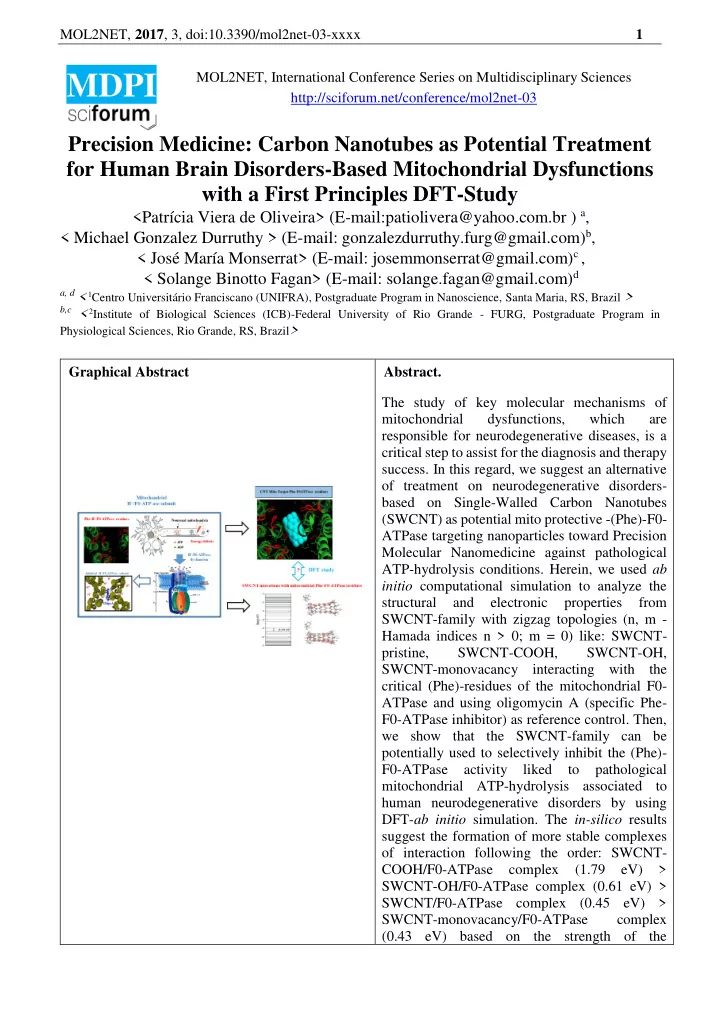

MOL2NET, 2017 , 3, doi:10.3390/mol2net-03-xxxx 1 MDPI MOL2NET, International Conference Series on Multidisciplinary Sciences http://sciforum.net/conference/mol2net-03 Precision Medicine: Carbon Nanotubes as Potential Treatment for Human Brain Disorders-Based Mitochondrial Dysfunctions with a First Principles DFT-Study <Patrícia Viera de Oliveira> (E-mail:patiolivera@yahoo.com.br ) a , < Michael Gonzalez Durruthy > (E-mail: gonzalezdurruthy.furg@gmail.com) b , < José María Monserrat> (E-mail: josemmonserrat@gmail.com) c , < Solange Binotto Fagan> (E-mail: solange.fagan@gmail.com) d a, d < 1 Centro Universitário Franciscano (UNIFRA), Postgraduate Program in Nanoscience, Santa Maria, RS, Brazil > b,c < 2 Institute of Biological Sciences (ICB)-Federal University of Rio Grande - FURG, Postgraduate Program in Physiological Sciences, Rio Grande, RS, Brazil > Graphical Abstract Abstract. The study of key molecular mechanisms of mitochondrial dysfunctions, which are responsible for neurodegenerative diseases, is a critical step to assist for the diagnosis and therapy success. In this regard, we suggest an alternative of treatment on neurodegenerative disorders- based on Single-Walled Carbon Nanotubes (SWCNT) as potential mito protective -(Phe)-F0- ATPase targeting nanoparticles toward Precision Molecular Nanomedicine against pathological ATP-hydrolysis conditions. Herein, we used ab initio computational simulation to analyze the structural and electronic properties from SWCNT-family with zigzag topologies (n, m - Hamada indices n > 0; m = 0) like: SWCNT- pristine, SWCNT-COOH, SWCNT-OH, SWCNT-monovacancy interacting with the critical (Phe)-residues of the mitochondrial F0- ATPase and using oligomycin A (specific Phe- F0-ATPase inhibitor) as reference control. Then, we show that the SWCNT-family can be potentially used to selectively inhibit the (Phe)- F0-ATPase activity liked to pathological mitochondrial ATP-hydrolysis associated to human neurodegenerative disorders by using DFT- ab initio simulation. The in-silico results suggest the formation of more stable complexes of interaction following the order: SWCNT- COOH/F0-ATPase complex (1.79 eV) > SWCNT-OH/F0-ATPase complex (0.61 eV) > SWCNT/F0-ATPase complex (0.45 eV) > SWCNT-monovacancy/F0-ATPase complex (0.43 eV) based on the strength of the
MOL2NET, 2017 , 3, doi:10.3390/mol2net-03-xxxx 2 chemisorption interactions. These theoretical evidences open new horizons towards mito-target precision nanomedicine. Introduction Neurodegenerative diseases are morphologically characterized, by the selective and progressive loss of neuronal tissue. These neurodegenerative disorders like: Alzheimer's, Parkinson's, sclerosis and Huntington's disease have common mitochondrial mechanisms-dysfunction [1]. Mitochondrial F1F0-ATP synthase c-ring subunit produces ATP from (ADP + Pi) in the presence of an H + -proton gradient across the membrane which is generated by electron transport complexes of the respiratory chain. F- type ATPase’s consist of two structural domains (F0 and F1). F0 -containing the membrane H + -proton channel and F1-containing the extramembraneous catalytic core toward mitochondrial intermembrane space. The F0-ATP synthase c-ring subunit structure is formed by the tens chain like A, B, C, D, E, K, L, M, N, and O. Here, oligomycin A (a specific inhibitor of F0-ATPase) can interacts with the outer and inner surface of the F0-ATP synthase c-ring subunit at a position that explains the inhibitory effect on the ATP synthesis. Key Phenylalanine residues (Phe) from the mitochondrial F0-ATP-ase binding-site are considered as critical in mitochondrial dysfunction-based pathological ATP-hydrolysis (ADP + Pi) in (ATP) [2,3]. These residues can directly regulate the H + -proton translocation based on great representatively in the structure aforementioned F0-ATPase chains, enabling multiple hydrophobic interactions associated to carboxyl side chains responsible for H + -proton translocation through the F0- ATP-ase subunit. Besides, the synthesis of Adenosine Triphosphate (ATP) in mitochondria is performed by a large molecular machine in the F1F0-ATP synthase. Under pathological conditions, like mitochondrial dysfunction, the Phe-residues from F0 subunit are involved in the inverse rotation that promote abrupt reduction of ATP synthesis by mitochondrial F1-ATP synthase given place the inverse process (ATP- hydrolysis syndrome). This biochemical mechanism can be inhibited by the oligomycin A Phe-F0- ATPase specific inhibitor that avoids rotation-inversion of the F0-ATPase subunit and thus cell death (apoptosis) [4,5]. The amino acid residues that form the oligomycin-binding site are 100% conserved independently of the phylogenetic position in all eukaryotic organisms. By the other hand, the Mitochondrial Nanomedicine has been gaining prominence, especially with the use of carbon nanotubes, which are considered as promising candidates for the treatment of diseases as neuronal regeneration due to its exceptional properties on the reduction of neurotoxicity, improvement of permeability, among others [6-8]. Besides, carbon nanotubes have properties as high specific superficial area and can cross the mitochondrial outer-membrane by endocytosis and other drugs-delivery mechanisms [9]. This work aims to evaluate the structural and electronic properties of the zigzag single-walled carbon nanotube (SWCNT), SWCNT-pristine, SWCNT-COOH, SWCNT-OH and SWCNT- monovacancy interacting with critical mitochondrial binding-site (Phe)-F0ATPase residues via ab initio simulation. The results can help to understand the therapeutic potential of these carbon nanomaterials to prevent/inhibit the pathological ATP hydrolysis from mitochondria in the nervous system and develop new therapeutic strategies to assist in the treatment of neurodegenerative diseases. Materials and Methods The zigzag topologies (n > 0; m = 0) from SWCNT-OH, SWCNT-COOH, SWCNT-pristine and SWCNT-monovacancy systems were selected based on previous molecular docking studies from highly conserved pdb-X-ray crystallographic structure of the yeast F1F0 ATPase C10 ring with oligomycin A (PDB ID: 5BPS). The arrangements showed a higher reactivity / nanotoxicity-based non-covalent interaction when compared with their similar SWCNT-armchair (n = m) and SWCNT-chiral topologies (n ≠ m), and presented as the closest phenyl alanine F0-ATPase residues [10]. It is important to clarify
Recommend
More recommend